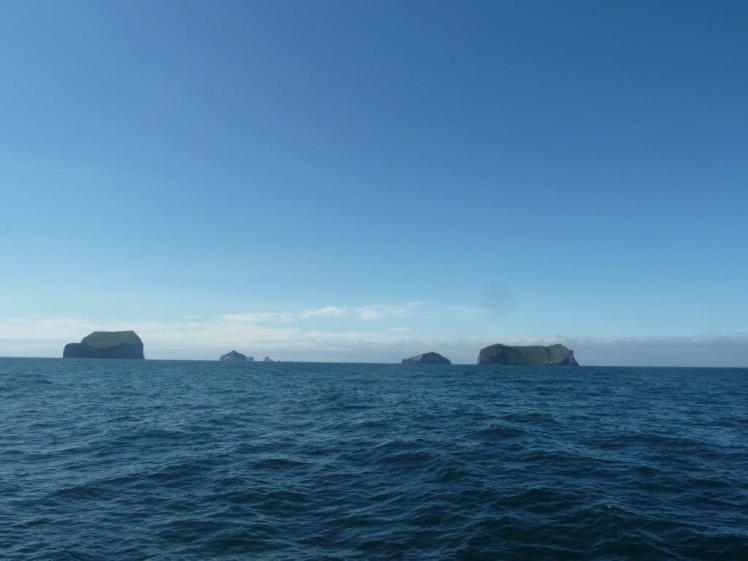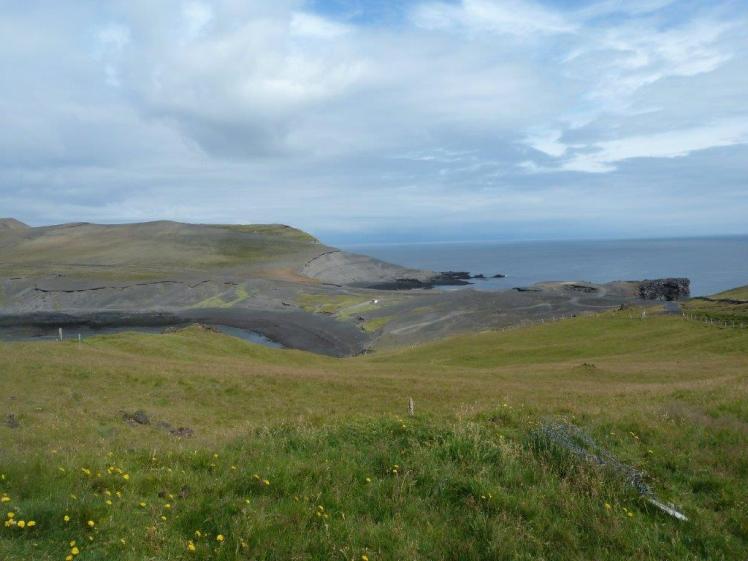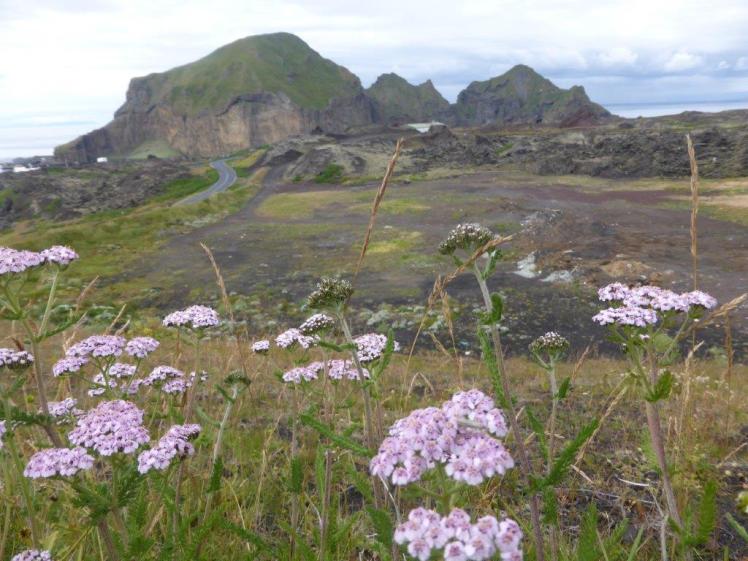This is another of those subjects I’ve been looking forward to writing since I started this series in January. W for Westman Islands.
The Westman Islands are a ragged little archipelago off the south coast of Iceland. They’re the tops of submarine volcanoes that have somehow exploded above the surface. The youngest is Surtsey which emerged from the waves in the late 1960s. It gave the world’s scientists a unique opportunity to learn about everything. From the basics like “how does the ocean affect newborn lava land?” (it erodes it very quickly. Surtsey is about a third of the size it was when it was first formed) to “how does life settle on new land?” That question’s a little harder to answer because life settles on remote North Atlantic lava formations pretty slowly. You can only go there as part of an official scientific exploration and they take contamination very seriously. You may get to float past it in a boat in good weather. The closest I’ve seen it is on the horizon from a RIB trip around Heimaey.

The only inhabited island of the group is Heimaey. I wanted to put “the only inhabited of the [x]-strong group” in there but I don’t know how many islands comprise the Westman Islands. How do you decide what’s an island and what’s just a bit of rock? Wikipedia has eleven named islands and three named “small islands” and mentions “about thirty rock stacks and skerries” but it also names one of the skerries among the small islands.
Anyway, the biggest is Heimaey, Home Island. It’s about four miles long and about two, two and a half miles wide and home to 4,500 people who are entirely dependent on fishing and tourism for their living on this desolate rock. It has a small airfield and that’s by far the quickest way to get there but it closes when the weather’s bad.

Most people arrive by car ferry from the new port at Landeyjahofn. It’s a purpose-built port on the closest bit of mainland and it takes around half an hour to chug over, which is a delight in good weather. Until that opened, you had to sail from Þorlákshöfn, which is quite a way further east and takes about two and a half hours. If you go over in winter, that’s the port you’re likely to go from.

The Westman Islands or more specifically, Heimaey, have/has three stories that I’d like to tell today.
The founding of Heimaey
The first permanent settler in Iceland was Ingólfur Arnarson in 870. Everyone knows that he threw his seat poles or chief poles or some kind of pole that symbolised being head of the household overboard, declaring that wherever Odin saw fit to land them would be where he made his home. He then spent the winter living on the nearest bit of coast while his slaves went searching for them. They found them on the southern end of a big bay on the west coast and Ingólfur subsequently named his new home Smokey Bay – Reykjavik. Yep, the capital is where that very first Viking decided to live.
But Ingólfur didn’t come alone. I’ve already mentioned his slaves. But he also brought his entire household, which presumably included his entire extended family. It certainly included a gentleman by the name of Hjörleifur Hróðmarsson. No one seems entirely sure who this was. “Brother” is usually included in the title. Clearly not actual brother – from their patronymics we can see that they didn’t share a father. Foster brothers? Brother-in-law? Brother-by-bonding? Best friend? Anyway, Hjörleifur came too and he decided to make his home on the rocky little islands on the south coast. Ingólfur went off and made his winter home and Hjörleifur settled down to his own new life on the island of dreams.
Except it didn’t last long. Hjörleifur was murdered by his slaves. You can’t blame them. They would have been stolen from Ireland or Scotland or one of the islands north of the British Isles and dragged across a very unpleasant bit of ocean, presumably at an unpleasant time of year – remember Ingólfur spending the winter waiting for his own slaves to return? – and they apparently were not amused. They made their own home on the island without their Viking master and the islands henceforth were known as the Islands of the Men from the West – the Westman Islands.

Algerian pirates
By July 1627, Heimaey was home to around 500 Icelanders. No longer Westmen, no longer Vikings. Iceland had been through the Settlement and the Commonwealth, had been Christianised, had come under Norwegian rule and was by now owned by Denmark. This was not a pretty period of history. Under the Danish trade monopoly, Iceland went hungry. Trade was permitted only at designated trading posts and merchants were forbidden to do anything other than trade. Iceland’s fishing territories became very small; anything further out was Danish.
And in the middle of all this, three Arabic pirate ships arrived and attacked Iceland. Those on the mainland fled into the lava fields and their stories are almost forgotten. Heimaey was another story. There’s nowhere to run on a rock sticking out of the ocean. The pirates stole or killed 242 of the islanders, taking them away to be sold into slavery in Algeria. A very small handful escaped or were released, among them Guðríður Símonardóttir, sometimes known as Turkish Gudda, who married Hallgrímur Pétursson. That name might not mean much to you but the big grey space shuttle church in central Reykjavik is named after him, Hallgrímskirkja. No happy or surprise ending to this story. For some reason, this story is often called the Turkish Invasion but they were Algerian. I guess to people in the North Atlantic in the 1620s, anything south of Norway was much of a muchness.

Lava bread
I’ve told the story of the islanders taking on a volcano and winning more times than I can count. It’s a great story. But my third story comes from the aftermath.
I’ve climbed Eldfell, the volcano formed by the 1973 eruption. It’s still hot. An inch down at the summit, the ground is red-hot and steaming. I’ve watched people make toast and melt Mars bars in holes in the ground on the top of that volcano.

For official visitors to Iceland, world leaders, international diplomats, that sort of person, they’re taken to Heimaey and taken up the volcano. A local baker buries some rye dough in a tub on the summit the day before and at this ceremonial occasion, the bread, cooked by the heat of the volcano, is dug up and eaten as a gesture of friendship.
Now, I don’t know if this story is true but I’ve heard it from three separate people so for now, we’re going with true.
A visitor had come from Spain. I don’t know if it was the King or the Infante or the ambassador, I can’t find that detail, but a visitor had come from Spain. He was brought to Heimaey. Everyone was very excited and then disaster! Right before they were due to go up the volcano, the baker realised he hadn’t buried the dough.
Well, there’s an easy answer. Bury a loaf that’s already been cooked. By the time the official party gets up there, it’ll be warm, it’ll look just like it’s been cooked overnight as per the tradition.
So this Spanish official gets up there. They dig up the bread and eat it and all is well. And then the Icelandic official, all bows and scrapes, says “And what did you think of our volcano bread?”
And, so says the legend, the Spanish official replies “It’s very good. And I didn’t know it came ready-sliced”.
Yeah, that’s why I have doubts as to the truth of this story.
And that’s my three stories from the Westman Islands. Next time, it’s a little bit early but I’ll be telling you about Xmas in Iceland.
